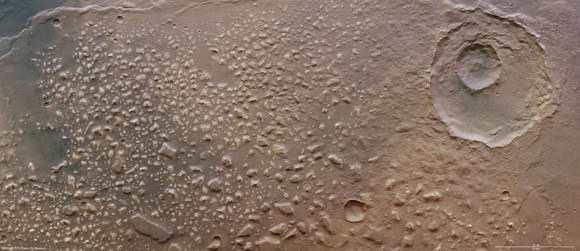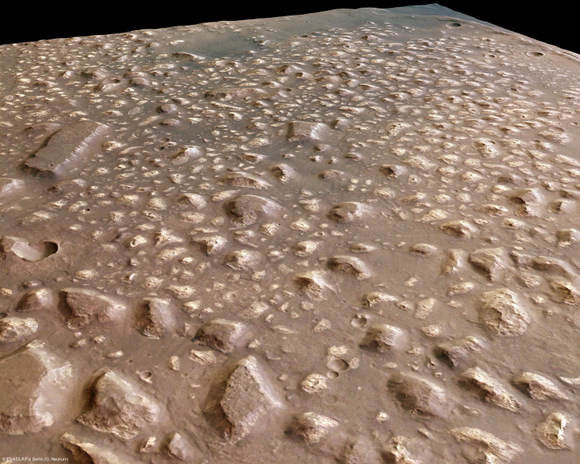[/caption]
Wow – what a shot by Mars Express! Mars has several regions of what is called ‘chaotic terrain’. These are areas with large accumulations of rocks of varying sizes, as well as flat-topped features. These erratically shaped rocks are large, too: between 1-10 km in size. Some chaotic terrain on Mars is thought to form when there is a sudden removal of subsurface water or ice, causing the surface material to slump and break into blocks. The region shown here, however — Ariadnes Colles — is not a water-source region, so scientists are still debating whether Ariadnes Colles was formed by the action of water or wind. Either way, this is a very interesting region. See below for a straight on view that’s just as incredible.

A large impact crater, 1200 m deep, is visible on the right, which has a smaller crater inside of it. The larger crater is about 30 km in diameter and covers an area roughly the size of Hamburg, Germany. The smaller younger crater lies almost at the center of the older one, and has a diameter of just 10 km.
Interestingly, the blocks, or mesas have a striking lineation, as almost all are oriented in the northwest-southeast direction. By looking at the larger versions, it’s possible to see the northwestern flanks have been eroded more strongly than the opposing southeastern ones.
Some slopes of the flat-topped mesas have been covered by darker material, likely sand or volcanic ash that was blown up on the slopes.
Anyone ready to visit this interesting region?
Source: ESA


This is quite possibly the most interesting scenery on Mars that I have ever seen. Imagine the exploring you could do there! So much variety. 😀 Mars Express rocks my world
Jumped on Google Earth – Mars to have a look at this area. There are 3 other instances of such terrain in reasonable proximity.
Atlantis Chaos (Location: 34.40°S 182.40°E) almost seems like the other side of the same rocky outcrop
Gorgonum Chaos is interesting as the breakup seems to be much fresher, reminds me of cracked dry clay. Location: 37.19°S 189.10°E
They all appear on (sunken plains: elevations are roughly 0 to -3km) Could they possibly have been Lakes?
Damian
If only we could have a Express for every moon of Jupiter, Saturn and beyond. To be able to explore every planetary body in our solar system like we can Mars now would be an amazing thing.
Its seriously the next best thing to being there atm.
Damian
The beauty of the Mars Express design is that it can be reused in missions to other targets, with some adaptations to local conditions. This means a great economy in I&D. The first of these is Venus Express, but I guess a similar mission could have been planned for Ceres and other Belt objects if Dawn hadn’t come along first.
For Mercury and for targets beyond the Belt, though, things are different. Mercury demands a LOT from radiation protection and heat dissipation, wereas beyond the Belt sunlight is too weak to provide adecuate energy levels in the current state of solar technology. I guess Jupiter might be accessible, or become accessible soon, but just barely. So any mission to those targets has to have a very different design, which means a lot of money allocated to technological development. Unfortunately ESA doesn’t have that kind of money, se we can’t have an Express in every interesting object of the Solar System.
It would surely be great, though.
Looks like a denser version of the terrain around Cydonia. Surely there’s a “Face” in there somewhere!
At first glance this landscape looks like arctic ice breaking up during a spring thaw. Could the impact which created the nearby crater(s) have provided the heat to do that?
How much of the fill between the remaining blocks has been transported from elsewhere? say during global dust storms?
We really need Google to add the Moon, Mercury and Venus to Google Earth. While I love visiting the mission websites, the revolution of using a tool like google earth to explore a planetary body is something else.
Now that the genie is out of the bottle, I would really like to see all the worlds space agencies collaborating on a deal that brings us the raw data that their spacecraft collect to a tool like google earth in an accessible format.
Perhaps there is even money to be made in the public forum that can feed back to space programs.
Damian
Awesome terrain-those 1-10km ‘rocks’ makes the highly vaunted Australian Ayers Rock look like a pebble, and with a terrain to match- a bunch of large flattops!!. Awesome!!
Looks like a chocolate bar!
@ star-grazer west coast:
thanks for the eye-opener – I’m just trying to imagine what it might feel like… actually being there! Yes, these “boulders thrown about” are huge mesas and rocky mountains – what a place to get lost in, trying to drive around on a rover….
The possible mechanism of removal of groundwater in creating this landscape set me thinking: does anyone know what the likelihood is of other planets in the solar system having cave systems? I know most caves on Earth are formed through solution of carbonates mainly in limestone, so does Mars have any similar geology that could contain caves? And what about other geology that is not Earth-like, such as ice planet/moons, are there any processes that could form cave systems there? I suppose lava-tube caves are pretty likely too, even on the Moon maybe. Just imagine what exploring caves under the surface of other worlds would feel like!
Question..hows the wind make a square? more accurately, a rectangle?great photo!
HelloBozos Says:
“Question..hows the wind make a square? more accurately, a rectangle?great photo!”
An illusion of perception?
By far the largest one of those mesas, about 10 km long, also has the least chaotic shape – this makes it stand out from the rest. If you saw it all on its own, I doubt you’d see it as rectangular.
You can see landscapes like this on Earth, but on a much smaller scale. Landscape features on Mars are generally much bigger than on Earth, due to the lower gravity.
I also doubt that it’s wind erosion – it looks almost identical to some much smaller water-created features on Earth, scaled up hundreds of times.
Great picture, indeed – I can’t tear myself away from looking at it. BTW, the main picture is not a photo. The terrain is modeled in 3D Software, the same kind the likes of Pixar use, and has the photo mapped on it as a texture.
Feenixx Says’
‘what a place to get lost in, trying to drive around on a rover’
Lol, I believe the highly dependable Rover would be a wreak in less than 100km, and the driver in worst shape!! But still, it would be an adventure to attempt the drive, although
I hope GPS would take care of me when I get lost and broken Lol
Can someone better versed in geology explain how water can cause this type of formation? I see that the article states that a sudden removal of subsurface water can cause it. So is this like a giant sink hole? and the mesas are just the parts that didn’t sink? either way, it’s a great picture and I would love to actually be there and see it.
That brick that I threw up in the air went higher than I thought it would.